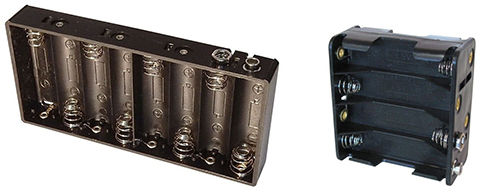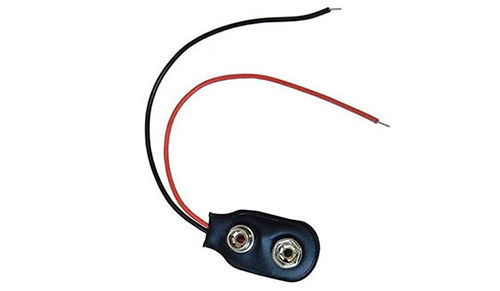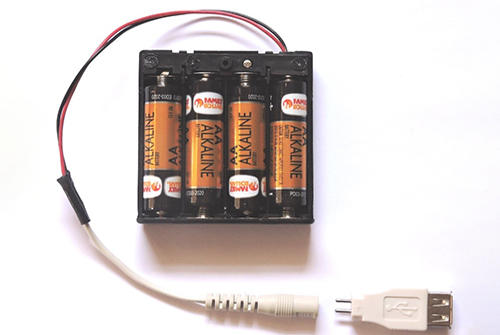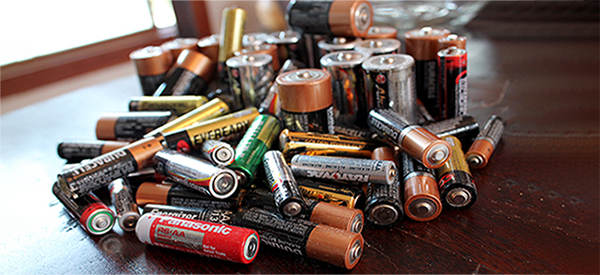The most common batteries on the market for small electronic devices are alkaline batteries. When these hit the market in the 1960s they revolutionized battery-operated electronics. Compared to the zinc-carbon “heavy duty” batteries they replaced, alkaline batteries have almost three times the energy density by volume, more than making up for their higher cost.
But alkaline batteries have another feature, which makes them even more attractive from a prepping and survival point of view; they have a very slow shelf discharge rate, making it possible to store them for long periods of time without them losing their charge. In fact, the major manufacturers of these batteries are now saying that they have an incredible ten-year shelf life.
The one drawback alkaline batteries have always had is that they have not been considered to be rechargeable batteries. All my life I’ve heard that they can’t be recharged. While there are now some “rechargeable alkaline” batteries on the market, their cost is high and they can only be recharged a limited number of times, unlike Ni-Cd or Li-Ion batteries.
The problem with recharging alkaline batteries is the same problem which affects many other kinds of batteries – heat. When batteries overheat they tend to swell, splitting the cases and leaking their electrolytes. Once that happens, they are worthless. If it happens when they are installed it can even damage your equipment.
Heat can also be a hazard when recharging Lithium-Ion batteries, which has prompted manufacturers to develop new technologies for recharging them, especially for the fast turnaround contractors need for their cordless tools. These newer methods of charging are carrying over to other areas, such as creating the means to safely and effectively rechage alkaline batteries.
Related: Which Batteries Are Best for Survival Situations?
Charging Alkaline Batteries
New battery chargers now exist which let you recharge alkaline batteries without them overheating. They do this by pulsing the electric charge into the battery, giving it a chance to recover and cool down. These chargers are available in a variety of capacities and prices, depending on your particular needs. I’ve seen ones which will charge as many as 16 AA batteries at a time, so that you always have charged batteries on hand.
But what if you don’t have one of these newer chargers; can you still charge your alkaline batteries with a “normal” battery charger?
The answer to this question is (surprisingly) yes; but you do have to be careful. Since the problem is heat, you have to ensure that your batteries don’t overheat during the charging process. This means cycling the charger on and off to allow the batteries to cool.
I suppose it would be most efficient to build some sort of circuit that cycles the charger on and off, just like the alkaline battery chargers use, but that could be a bit complicated. Rather, I would place the charger close to wherever you are working, where you can reach over and turn it on and off, or unplug it if necessary, allowing the batteries to cool.
This will add to the overall charging time, but most of us have enough dead AA or AAA batteries sitting around that we could easily make a regular habit out of charging them, giving ourselves a bank of charged batteries to work from. Since alkaline batteries self-discharge slowly, they would then stay charged while sitting in a box on the shelf.
Get The Most Out Of Those Batteries
But there’s another way to get more use out of your alkaline batteries than just depending on recharging them. That’s to deep cycle them before recharging.
When we’re talking about alkaline batteries, we’re usually talking about AA, AAA, C and D cells. All of these produce a nominal 1.5 volts. Typically the electronic devices they power hold more than one battery, connected together in serial to boost the voltage.
The most common sizes today are AA and AAA batteries, with four batteries usually being used together to produce a nominal 6 volts. If we assume that the device they are being used in runs at 5 volts (the same power output for a USB charger or USB port on a computer), then those batteries are considered “dead” when they are at 1.25 volts. But that doesn’t mean that they can’t produce any electrical power at all.
To get back over that 5 volt threshold, so that the device the batteries were running works, we either need to recharge the batteries, replace them, or hook more of them together. This third option is actually much easier than you would expect. All that’s required is an eiht-bay battery holder. These can be purchased from any electronics parts supply company. Two different styles are shown in the pictures below. Eight “dead” AA batteries will produce 9.6 volts, well over the 5 volt threshold we need. The extra power won’t cause any problems, as the device’s internal voltage regulator will adjust it. Even so, you could use 6 batteries, rather than 8, producing 7.2 volts. The extra two slots in the battery holder can be filled with “dummy” batteries made by cutting dowel rod and covering it with aluminum foil. Sorry – nobody makes holders for six batteries, for some reason.
Eight “dead” AA batteries will produce 9.6 volts, well over the 5 volt threshold we need. The extra power won’t cause any problems, as the device’s internal voltage regulator will adjust it. Even so, you could use 6 batteries, rather than 8, producing 7.2 volts. The extra two slots in the battery holder can be filled with “dummy” batteries made by cutting dowel rod and covering it with aluminum foil. Sorry – nobody makes holders for six batteries, for some reason.
In addition to the battery holder you’ll need a way of connecting it to the device. This means using a 9 volt battery clip, like in the photo below, and soldering the appropriate sized connector to the other end, to fit the device you want to use the battery pack with. Another option is to connect a Female USB connector to the battery holder, allowing the unit to be used as a phone charger or for any other device which will run off of a USB port, either for charging or for operation.
Another option is to connect a Female USB connector to the battery holder, allowing the unit to be used as a phone charger or for any other device which will run off of a USB port, either for charging or for operation.
You can also use dummy batteries made of dowel again, this time without the foil covering. You’ll need two, each with a metal cover at one end; connect the wires from the battery pack to these covers. Now put a dummy in the first and last bays in your device, with the connections from the positive and negative terminals of the holder contacting the appropriate terminals in your device.
Please note that it is still possible to recharge these batteries, even after drawing them down beyond the point where they’d usually be “dead”. The only difference is that it will take longer for the battery to recharge, as the starting level will be even lower than normal.
You may also like:
 Turn a Car Battery Into an Emergency Power Source For the Home
Turn a Car Battery Into an Emergency Power Source For the Home
7 Actions to Take Immediately Following an EMP Strike (Video)
9 Places Where You Can Find Energy After An EMP
The Battery That Can Power Your Home Completely Off The Grid















An electric light timer may be one solution for power cycling the charger. An analog timer capable of multiple cycles per day can be purchased at Lowe’s, Home Depot, etc. I have one set up for turning on a fan for my birds during the day. With this particular timer, I can turn any electrical device on/off every 15 minutes.
If the alkaline batteries need to stay cool as they are recharging, would it work to put the charger w batteries in a freezer while they are recharging?
I can’t give a definite answer on that one, but I don’t think it would be a good idea. It could stress the batteries; the temperature inside your freezer is well below what they’re happy operating at that. I’d go with either a timer or just unplugging he charger for a few minutes whenever the batteries start to feel too warm.
Not good for freezing them, however, you can put the batteries in the refrige to cool them off, before charging, as it conglomerates the inner material, bringing the juice particles to the center rod, getting rid of the bubbles that form inside alkaline batteries.
Also, what would be wrong with setting up a solar panel for the little LEDs and other lights, to recharge the little batteries in a window?
There are two ways to find out the charging cycle for alkaline batteries. One, is to experiment. The other, buy, or get the loan of a charger and monitor the charging with a voltmeter. Record the on-off times of the charger. To build one of your own, I would use a 555 timer set for a recurring cycle for on and off times. You would have to make the 555 circuit self resetting, or use a variation of the 555 which has this as a built in function. The time output would then go to a transistor, a power type transistor, either a bi-polar or a FET type transistor. When the timer is in the on state, the transistor is turned on, and charging current goes to the battery. In the timer off state, the transistor is off, no current to the battery, and the battery can cool.
The preparedness this website helps to promote and teach is great. Having batteries is definitely a good point as well. I just wish all of America had the mindset to have at least a week of supplies of all kinds on hand 24/7. I just watched a ten second video of folks at a Walmart in North Carolina scrambling and tussling over cases of bottle water. They are in panic mode because they don’t have the foresight to get these things in place before disaster hits. Entities like Mercury One, Salvation Army, and dozens of smaller private organizations as well as FEMA keep food, water, blankets, medical, feminine products, baby items, eating utensils, etc… stored and ready to go to help those in need. They don’t wait until three days prior then go get the stuff when the shelves are empty. Lord Jesus please help me understand why don’t the masses have said things already in place? Most of the good people who post on this website are not cooks who just sit around waiting for the end of the world but are hard working, tax paying contributing citizens with families, car notes, House notes, kids in college, elderly parents young children trying to make it from day to day. Don’t rely on any group to step in and save the day because it is always limited. You take the personal responsibility to take care of your family. If all had this mindset then the need would not be as great. To the folks in the path of this hurricane Florence my prayers are with you and I hope you have taken necessary steps to provide for your family because the shelves are empty, the gas pumps are struggling and it is fixin to get worse. God bless you all.
Here’s what I do: Use an adjustable bench power supply; one with meters and adjustment knobs for voltage AND current. I’m an electronics engineer, so I have several of these but you can put “adjustable power supply” in your favorite search engine and find them for pretty cheap. You don’t need high precision, and you don’t actually WANT high current, so that keeps the price down.
Set the voltage for about 125% of the rated voltage for your battery. I use 12V for 9V batteries and 1.9 – 2.0V for single cells.
Now turn the current limit as low as it goes, and then (this is the weird sounding part) short the output. Yes, short the output of the power supply. Now, with the output shorted, turn the current up slowly to about 50mA (.05A).
Now, un-short the power supply and connect it to the battery you want to charge.
And there you go. The battery will get slightly warm but should not get hot. When the current starts to decrease, or if the battery DOES start to get actually hot, it’s done.
Radio Shack used to sell a battery recharger that recharged all kinds of batteries, including regular alkaline batteries.
It took something like 22 hours to recharge a pair of alkaline batteries (very SLOW rate of charge).
It could even recharge 9V batteries too
Amazon
MaximalPower FC999 Universal Rapid Charger for Alkaline, RAM, Ni-MH, Ni-CD, AA, AAA, C, D, 9V Batteries,Black
You say these new chargers are available, but i see no listings that say they can be used for non-rechargeable batteries. which chargers will work?
Thank you for these suggestions.
On charging these AA and AAA batteries what I did as a test and it worked was to use those dollar store garden lites that have solar panel on top. I’d buy them when they were just a buck. Take the original battery out and put in a dead one, put it in the yard and in usually a day or 2 they would be charged back up. Worked for me for cheap. Worth a try if you can find those still for a buck.